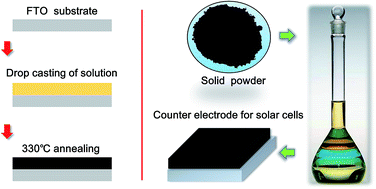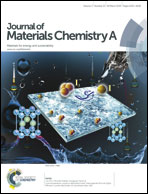Low-temperature, solution-deposited metal chalcogenide films as highly efficient counter electrodes for sensitized solar cells†
Abstract
Transition metal chalcogenide crystalline films FeSe2, Cu1.8S, and CuSe have been deposited from solution by drop casting their dissolved inks onto a conductive substrate, followed by a mild thermal treatment. We demonstrate that the resulting chalcogenide films exhibit an excellent catalytic activity and function as highly efficient counter electrodes (CEs) for dye- and quantum dot-sensitized solar cells (DSCs and QDSCs). In particular, the FeSe2 and CuSe films produced herein with novel morphologies show better catalytic activity than that of the conventional Pt coated CE used in DSCs and Cu2S in QDSCs, respectively. Ensuing devices present an improved photovoltaic performance with maximum values of 9.10% for DSCs and 4.94% for QDSCs, comparable to those based on Pt and Cu2S CEs. The efficient CE materials developed here from such a facile and scalable route offer strong potential for a broader solar cell application that requires low-cost and large-scale production.


 Please wait while we load your content...
Please wait while we load your content...